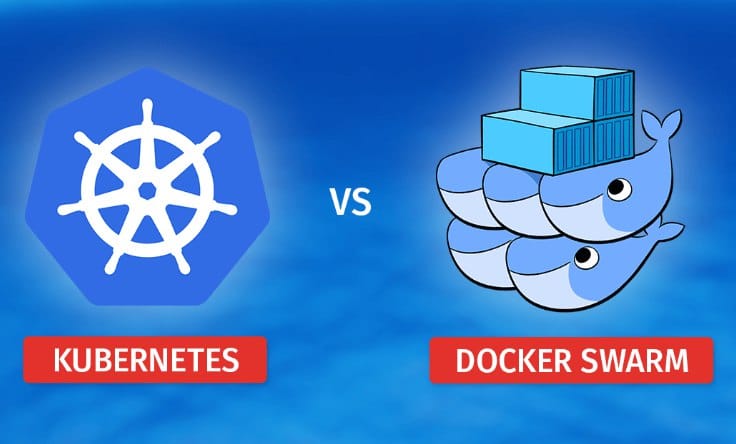Kubernetes vs. Docker Swarm: Choosing the Right Container Orchestration Tool
In the modern application development landscape, container technology is the best ally for businesses and developers to deploy and manage complex applications.
Containers are brilliant at packaging and holding all application codes, dependencies, libraries, and necessary configurations in a way that you can run your application anywhere easily.
However, to scale and manage containers, a robust container orchestration tool is a must. And when it comes to choosing the right orchestration tool, two names emerge as the best options– Kubernetes and Docker Swarm.
As we go through this blog, you will get to learn more about Kubernetes and Docker Swarm, along with their advantages and disadvantages. In the end, we will also help you choose the best orchestration tool for your application.
What is Kubernetes?
Kubernetes, also known as K8s, is an open-source container orchestration platform for applications. Initially developed by Google, Kubernetes is a powerful tool that allows developers to automate the deployment, scaling, and management of complex containerized applications.
The platform provides a range of features, including service discovery, storage orchestration, load balancing, and automated rollbacks and rollouts. Keeping all these features in mind is important while comparing Kubernetes vs. Docker Swarm and choosing the right container orchestration platform.
Advantages of Kubernetes
As a robust container orchestration platform, Kubernetes offers the following advantages:
Scalability- A defining feature of Kubernetes is its seamless scalability. It effectively manages large-scale containerized applications and efficiently allocates workloads across a large cluster of nodes.
Declarative Configuration- Kubernetes supports declarative configuration, enabling you to define your application’s desired state. This method simplifies application management and updates by allowing configurations to be specified in files.
Rich Ecosystem- Kubernetes features a vibrant ecosystem that includes a wide range of tools, extensions, and a supportive community. This ecosystem enhances its functionality and offers solutions for diverse use cases.
Self-Healing- Kubernetes includes strong self-healing capabilities. In case a container or node fails, Kubernetes automatically reschedules and recovers, maintaining high availability and reliability.
Disadvantages of Kubernetes
While Kubernetes has numerous significant advantages, it also presents several drawbacks to consider before choosing it. These include:
Steep Learning Curve- Kubernetes comes with a steep learning curve that requires specialized knowledge for managing nodes and various functions, such as Pods, ConfigMaps, and Namespaces.
High Complexity- A major drawback of Kubernetes is its complexity, which may be excessive for managing simple workloads or applications, like deploying a basic stateless website or a documentation site.
Limited Migration Capabilities- Transitioning from another orchestration platform to Kubernetes can be quite challenging, as every configuration must be converted into a K8s object before migration.
High Resource Requirements- Kubernetes imposes significant resource requirements, both in terms of hardware and human resources. Setting up and maintaining a Kubernetes network can be resource-intensive.
What is Docker Swarm?
Docker Swarm, also known as Swarm Cluster, is a native container orchestration and clustering tool for Docker containers. Docker Swarm is known for its simplicity and seamless integration with Docker applications. If you are already familiar with Docker, getting started with Swarm can be a smooth transition.
Docker Swarm helps developers to deploy and manage multi-container applications across multiple nodes, providing a simple, unified approach to container orchestration. Docket Swarm consists of three main components: Swarm manager nodes, Worker nodes, and Load Balancers.
Advantages of Docker Swarm
Docker Swarm is a great container orchestration platform due to the prominent advantages it offers. This includes:
Ease of Use- Docker Swarm is designed to be user-friendly, with a minimal learning curve. Setting up a Swarm cluster is straightforward, making it an excellent choice for smaller projects or teams with limited experience in container orchestration.
Smooth Integration- Docker Swarm is an integral part of the Docker ecosystem, and thus it offers seamless integration with Docker tools and commands. This integration simplifies tasks like service creation and scaling.
High Scalability- Docker Swarm is known for its ease of scaling. It supports both manual and automatic scaling of services, making it simple to adjust the number of replicas based on demand.
Built-in Load Balancing- Docker Swarm automatically distributes traffic between containers. It helps to optimize resource utilization and ensures high availability of services. Additionally, it reduces the risk of system overload.
Disadvantages of Docker Swarm
Although Docker Swarm offers some exciting advantages like seamless integration, it also has some noticeable disadvantages. Such as:
Limited Functionalities- Docker Swarm comes with limited functionalities such as volume management. This is because it was designed to be a simple and efficient orchestration tool and lacks all of the features available in standalone Docker.
Basic Security Features- Docker Swarm lacks advanced security controls like RBAC. It provides TLS encryption and mutual authentication, but finer access controls and policies are not robust.
Less Extensible- Docker Swarm offers limited third-party integrations. It does not have an extensive ecosystem of plugins, monitoring tools, and networking options, which can limit flexibility.
Weaker Fault Tolerance- It does not offer advanced self-healing capabilities. If a node fails, the system attempts redistribution, but the recovery process is not seamless or automated.
Kubernetes vs. Docker Swarm: Which One to Choose?
Till now, we have discussed everything about the two best container orchestration platforms. We know about their major advantages as well as disadvantages. But the main question still persists– which one should you choose between Kubernetes and Docker Swarm?
Choosing a container orchestration tool is not a one-size-fits-all decision. It depends on the specific needs and characteristics of your applications. You should choose the one that perfectly aligns with your application’s requirements, your team’s expertise, and your deployment goals.
You can choose Kubernetes when;
- You need enterprise-grade orchestration with advanced automation.
- Your application requires high availability and robust security.
- You are managing complex, large-scale applications.
- Your infrastructure spans multiple cloud environments.
You can choose Docker Swarm when;
- You want a lightweight and easy-to-use orchestration tool.
- You are working on a small-to-medium-sized application.
- You need quick deployment and straightforward cluster management.
- You are already using Docker and prefer native integration.
Wrapping Up Kubernetes vs. Docker Swarm
To wrap it all up, both Kubernetes and Docker Swarm are powerful container orchestration tools, each with their unique advantages. Kubernetes is ideal for enterprises requiring extensive automation, scalability, and security. On the other hand, Docker Swarm is perfect for teams looking for simplicity and ease of use.
When choosing one between Kubernetes vs. Docker Swarm, you must assess your application’s complexity, scalability requirements, and your team’s expertise. In the end, the ultimate goal remains the same– to efficiently manage and scale your containerised applications.




